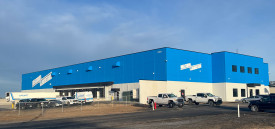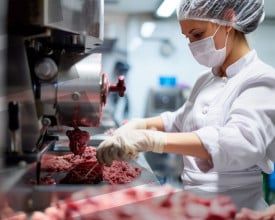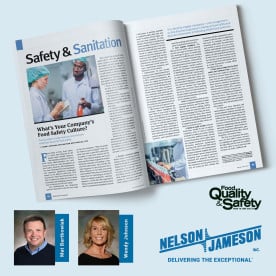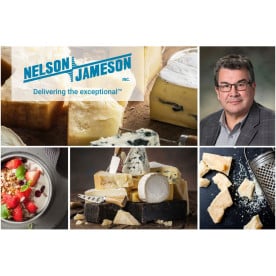Monthly Archives: September 2012
- September 26, 2012
From August through October, “The Wide Line” blog will feature a series of columns authored by Dan Strongin, a well-known name in the food industry.
- September 11, 2012
For the next two months, “The Wide Line” blog will feature a series of columns authored by Dan Strongin, a well-known name in the food industry.
A Conversation with Diane Sutton, Product Manager, Nelson-Jameson, Inc.
I wanted to let you hear from someone working for Nelson-Jameson to see how they perceive the company and its role in the food and beverage industries, from their point of view. I will do this for a couple of posts, and then give the owner, and top management a chance to chime in as well.
So Diane and I arranged to “sit down” over the internet, and have a chat. What follows are excerpts, in no particular order, of Diane’s perspectives on Nelson-Jameson:
“We service small,
- September 04, 2012
For the next two months, “The Wide Line” blog will feature a series of columns authored by Dan Strongin, a well-known name in the food industry.
An obsession with cutting costs can actually wind up costing you more; buy low, sell high is an oversimplification. Let’s cast catchphrases aside and explore this beast called the supply chain, with an eye to make more money.
Commonly called a “chain,” it links the steps to move a product from farm to table. For our purposes, think of it more as a pipeline; it makes it easier to understand the overall flow, which is where you find the magic.
The supply pipeline begins at the farm, and at the other end, is the consumer.
Imagine product flowing in one end as raw material, and money flowing back from the other end, backwards from the consumer.
Rules of the Pipeline as We Know It
- Money exchanged within the pipeline merely changes hands; the overall amount remains steady, (more money in the pipeline can only come from the consumer, barring a sweet deal with Congress for subsidies).
- The law of supply and demand applies only to a point, as people can only eat so much.
- Everyone in the pipeline but the consumer has to fight among themselves to gain an advantage, or so they think...
- So they upstream costs by squeezing their supplier (except the poor farmer who has no one upstream to squeeze!).
- They also try and downstream sales, sometimes bypassing their customer.
- In other words, they shorten the distance between them and the source, or between them and the consumer, therby shortening the supply chain. Less players, more profit! Makes sense, right? Wrong!
In the process of trying to outsmart each other, something interesting happens:
- To get a better price, buyers cherry pick, or buy direct, in bulk,
- diverting the flow of money into inventory,
- Standing inventory, like water, stagnates, it ties up money,
- in the end, robbing the pipeline, so everyone ends up fighting over an ever smaller flow.
While some inventory may be necessary, excess inventory is evil. It...
- loses quality every minute it sits,
- loses value every minute it sits beyond when ready to use or sell
- has to be managed, so you have to
- rent space, or use what space you have, which could be used for productive, revenue generating purposes
- takes people to manage the inventory... and they make mistakes!
- Goods don’t get rotated; are lost; damaged; or ….
- is date stamped, and the clock never stops ticking.
- has to be counted.
- Suddenly, rather than focusing on products and selling them, you spend valuable resources moving boxes around, writing reports, and putting out fires!
With less money available in the pipeline, no one really ever wins for long, despite continuously trying.
Money socked into unnecessary inventory cannot pay for things like salaries, electricity, or more raw materials to do your magic on and sell, (items that are moving, not sitting in a lump waiting). It has to come from somewhere, and too often it comes from credit. Now multiply these costs by everyone in the pipeline except the consumer. Not only is it hurting everyone –it is hurting you as well. Spreading inventory around is not the same as generating wealth.
If you are a buyer, you have to admit, you barely rest, always trying to stay ahead of the eight ball. It is a Catch-22, like that finger puzzle made of straw where you stick your fingers in and try and pull them apart. As you pull, it only squeezes with ever greater force, the harder you pull.
Despair not, there is hope! Distance is not the only resource: there is time as well. To shorten the time in the pipeline means shortening the time raw materials stay in the pipeline from farm to consumer, who, by the way, consumes the product. It is the theoretical basis of “Just in Time.” (Google™ it!)
The shorter the amount of time between the purchase of the raw material and the final sale, the more money from that purchase remains in the pipeline. Since it is unlikely the cow will be milked or the grain grown the same day the product is made, sold, and consumed, some inventory has to be maintained in order for it to work.
Don’t take my word for it: Sam Walton revolutionized the supply chain and built the largest company in the world understanding it. Apple computer is profitable not only due to its snazzy design, but the current president figured out shipping iPods® in small amounts by air would cut overall inventory and shorten the time in the pipeline to where it would make them much more money, though air freight is infinitely more expensive than shipping in ocean containers. When you buy an iPod at an Apple Store, the computer sends a message to the factory in China for one iPod to be added to a purchase order. As soon as they have enough, iPods are manufactured and shipped, same day, cutting Apple’s supply time to less than two weeks, avoiding the burden of managing inventory.





